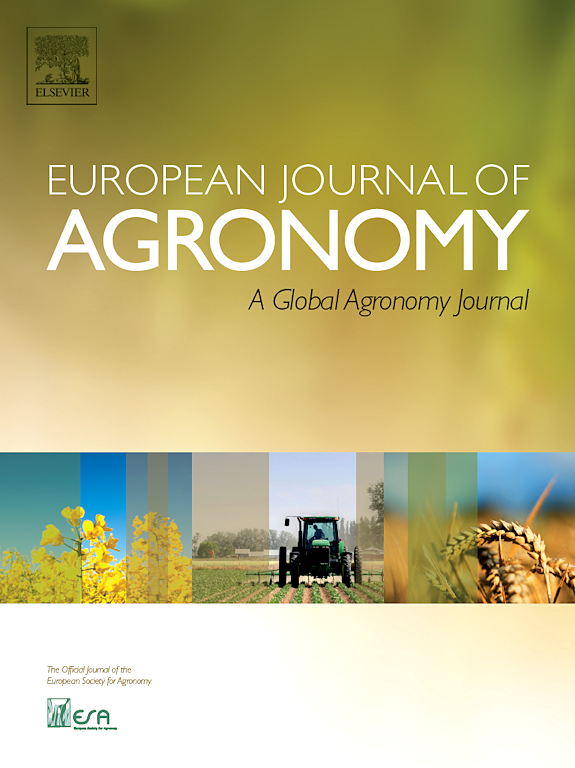View Item
- xmlui.general.dspace_homeCentros Regionales y EEAsCentro Regional Buenos Aires SurEEA BalcarceArtículos científicosxmlui.ArtifactBrowser.ItemViewer.trail
- DSpace Home
- Centros Regionales y EEAs
- Centro Regional Buenos Aires Sur
- EEA Balcarce
- Artículos científicos
- View Item
Shoot- and tuber-based critical nitrogen dilution curves for the prediction of the N status in potato
Abstract
Critical nitrogen (N) dilution curves describe the critical N concentration in plant tissues during crop growth and they are used to estimate the N nutriton status of whole plants in potato. Little is known, however, about the critical N dilution curves in specific plant parts such as shoots and tubers. Our objectives were (i) to determine critical shoot and tuber N dilution curves; (ii) to compare these curves with critical N dilution curves determined
[ver mas...]
Critical nitrogen (N) dilution curves describe the critical N concentration in plant tissues during crop growth and they are used to estimate the N nutriton status of whole plants in potato. Little is known, however, about the critical N dilution curves in specific plant parts such as shoots and tubers. Our objectives were (i) to determine critical shoot and tuber N dilution curves; (ii) to compare these curves with critical N dilution curves determined on whole plants (shoot + tubers); and (iii) to assess the possibility of using the critical shoot and tuber N dilution curves to estimate the N nutrition status of potato and tuber quality. Seven potato cultivars were assessed under different N supplies and environmental conditions in Canada and Argentina. Shoot biomass (leaves + stems) and tuber biomass along with their N concentrations were measured at regular intervals during the growing season. Tuber yield, dry matter concentration, and nitrate (N-NO3−) concentration were measured at harvest. We determined the coefficients of the critical N dilution curves expressed as N = a × W-b with N as the N concentration in shoot or tuber biomass, and W their respective biomass. Among cultivars, coefficients a and b for shoot biomass ranged from 5.08 to 5.68 and from 0.18 to 0.28, respectively, while coefficients a and b for tubers ranged from 1.54 to 1.87 and from 0.17 to 0.21, respectively. The shoot (NNIsh) and tuber (NNIt) N nutrition indices were both highly related to the N nutrition index in whole plants (R2 = 0.88; R2 = 0.98; P < 0.05; respectively) and to relative tuber yields (R2 = 0.61; R2 = 0.53; P < 0.05; respectively). For a NNIsh or NNIt ≥ 1.00, the relative yield was near 95 %, while it decreased with decreasing NNIsh or NNIt below 1.00. The tuber N nutrition index at harvest was related to tuber dry matter concentration and tuber N-NO3- concentration (R2 = 0.30; R2 = 0.53; P < 0.05; respectively). Our results demonstrate that shoot and tuber N nutrition indices identified adequately the N status in potato cultivars and tuber quality and, therefore, they have potential as plant diagnostic tools to estimate the N status of potato crops across different cultivars and environmental conditions.
[Cerrar]

Author
Giletto, Claudia;
Reussi Calvo, Nahuel Ignacio;
Sandaña, Patricio;
Echeverria, Hernan Eduardo;
Bélanger, Gilles;
Fuente
European Journal of Agronomy 119 : 126114 (20220)
Date
2020-09
Editorial
Elsevier
ISSN
1161-0301
Formato
pdf
Tipo de documento
artículo
Palabras Claves
Derechos de acceso
Restringido
 Excepto donde se diga explicitamente, este item se publica bajo la siguiente descripción: Creative Commons Attribution-NonCommercial-ShareAlike 2.5 Unported (CC BY-NC-SA 2.5)
Excepto donde se diga explicitamente, este item se publica bajo la siguiente descripción: Creative Commons Attribution-NonCommercial-ShareAlike 2.5 Unported (CC BY-NC-SA 2.5)

